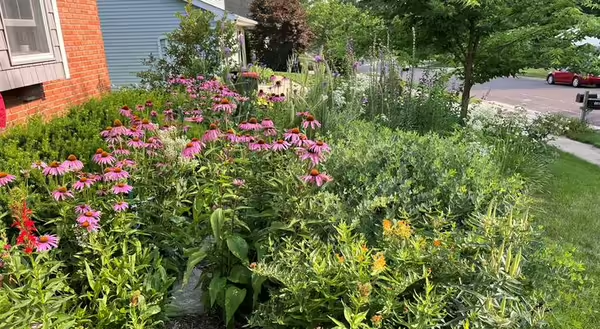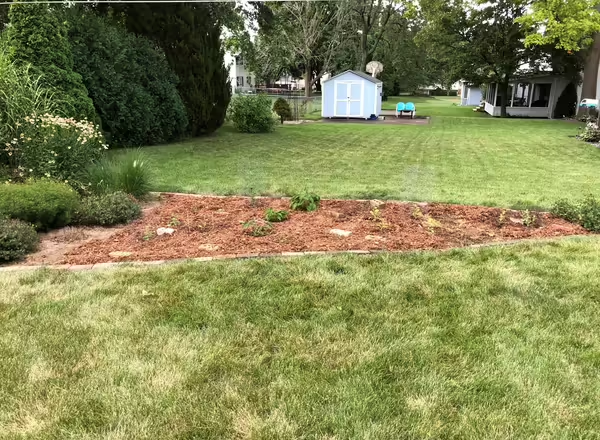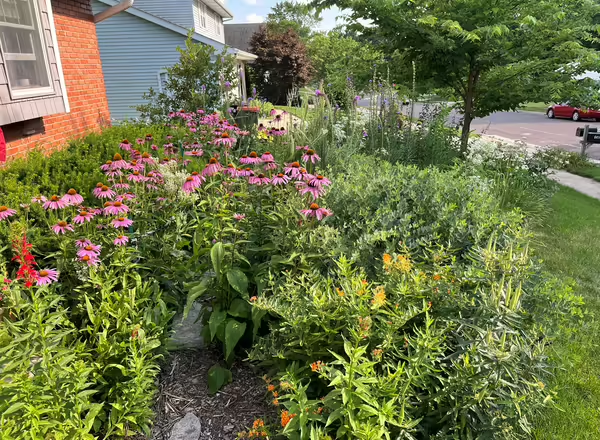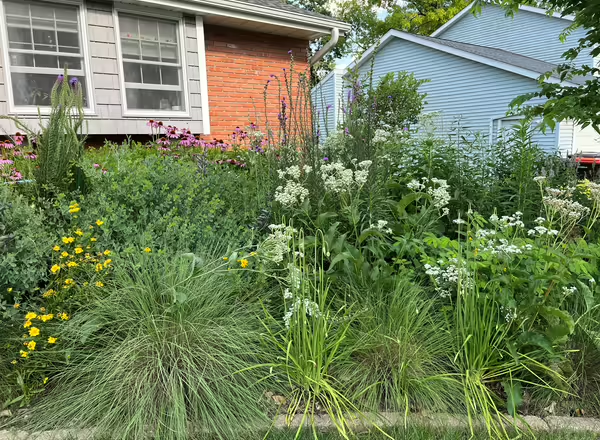
By Laura Hertz, Illinois Extension Master Gardener serving Fulton, Mason, Peoria, and Tazewell counties
In 2018, I became aware of the importance of native plants after listening to a webinar featuring Doug Tallamy, an entomologist from Dartmouth most known for his books Bringing Nature Home and Nature's Best Hope. He completely changed my thinking about the function of landscaping; rather than focusing solely on aesthetics, plants could be beneficial contributors to the microenvironment of a yard and supply habitat for myriad living things. And still be aesthetically pleasing! Insects and birds are only able to contribute to the food web when they have the food (plants and insects) with which they co-evolved.
So, between the spring of 2019 and the summer of 2023, my husband and I slowly worked to convert much of our turf into native plant beds, and replace ecologically devoid plants with plants that help nature. We now have over 50 species of native flowering plants, shrubs, and trees. We have noticed an increase in the nesting birds and especially an increase in native bees.
"The first year they sleep. The second year they creep. The third year they leap."
I started my endeavor by smothering sections of turf, which is slow but cheap. After preparing the planting areas, I purchased native plant plugs- little pots with ample roots. At first, the little plant plugs looked so fragile and vulnerable to munching rabbits and mischievous chipmunks. I was advised of the adage "The first year they sleep. The second year they creep. The third year they leap." It has been so!
Since the plants have grown and filled in the space, I no longer have to worry about rabbits or chipmunks decimating plants- there is plenty to share. We completely replaced our terrace grass with native plants, eliminating the need to mow that pesky lawn strip by the curb. Although we still have some non-native plants in the yard, they are vastly outnumbered by plants that provide food, nectar, and habitat for local and migrating wildlife. Native plants are quite low-maintenance, suited as they are to dry, hot summers. They do not require fertilizer and I almost never water any of it.
The first local C@H member
When I learned about the Conservation @Home initiative, I felt pretty confident that our little quarter-acre would be a contender. In addition to the many plants, my husband is diligent with keeping the bird bath and bird feeders filled. We have a compost pile. I try to leave as much plant material on site as possible. We planted a red oak, serviceberry trees, and a redbud. I've added some fallen logs for the insects, and leave some bare ground for bees to nest. In the winter, the dried heads of the rattlesnake master and coneflower catch the snow like an icy gumdrop, and the hollow stems of the sedum and bluestem are left to house overwintering insects. I am proud to have the Conservation@Home sign displayed prominently!
Future goals
There are still improvements to make and knowledge to acquire. I'd like to replace two privacy burning bushes with chokeberry. I'd like to smother more grass and replace it with sedges or flowers. I want to add a sassafras tree. I'd like to learn more about which plants are hosting which insects and birds.The recently released book The Gardener's Guide to Prairie Plants (Diboll & Cox) and Pollinators of Native Plants (Holm) are waiting on the shelf for me to study them intensely. I wish to thank Pat Alexander for bringing me into the fold of her native gardens and sharing many plants with me. I'm paying it forward.




